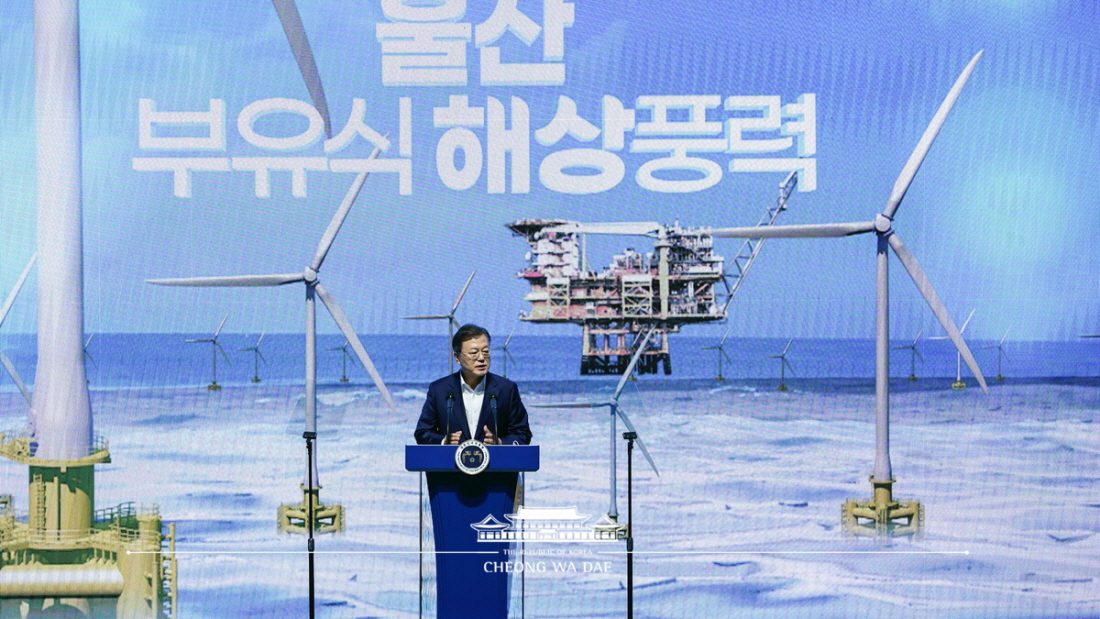이 웹사이트는 제19대 대통령 임기 종료에 따라 대통령기록관이 「대통령기록물 관리에 관한 법률」에 의해 이관받아 서비스하는 대통령기록물입니다. 자료의 열람만 가능하며 수정 · 추가 · 삭제는 불가능합니다.
다만, 「개인정보보호법」에 의하여 개인의 정보를 보호받기 원하시는 분은 관련 내용(요청자, 요청내용, 연락처, 글위치)을 대통령 웹기록물 담당자(044-211-2253)에게 요청해 주시면 신속히 검토하여 조치해 드리겠습니다. 감사합니다.
SPEECHES & REMARKS
BRIEFINGS
Remarks by President Moon Jae-in at Strategy Presentation for Floating Offshore Wind Farm in Ulsan

Fellow Koreans and citizens of Ulsan,
Since far-off prehistoric times, the sea has been an integral part of life for this region. During the Three Kingdoms period, Ulsan served as a gateway for trade ships coming and going. From the 1970s when Korea’s first maritime industrial complex was established, Ulsan spearheaded the Republic of Korea’s industrialization through exports.
The East Sea gas field in the waters off Ulsan has made Korea the world’s 95th oil producing country as we have been able to extract natural gas with our own technology from 2,000 meters under the sea there. And today, Ulsan is embracing the sea to take on yet another challenge.
On the very spot where the flames of the East Sea gas field are dying down, the world’s largest floating offshore wind farm will be built by 2030. A public-private joint investment totaling 36 trillion won will be injected, and some 210,000 jobs will be created. Ulsan will vigorously take off as an industrial capital in the era of clean energy as it had in the fossil fuel age.
I extend my deep respect and gratitude to Ulsan citizens, Mayor Song Chul-ho and city officials, businesses and universities at home and abroad as well as relevant research institutions. They have embarked on a bold journey in step with the changing times. I also wish to thank Chairman Song Young-gil of the ruling Democratic Party of Korea, who is joining us to encourage Ulsan as it takes on this challenge.
Fellow Koreans and citizens of Ulsan,
Countries around the world are currently making all-out efforts to respond to climate change and achieve carbon neutrality. At the same time, they are eyeing floating offshore wind farms as an alternative source of new and renewable energy. Unlike the fixed types rooted in the ocean floor, the power generating units on these offshore wind farms are installed on the floating structures themselves.
Able to be built above great depths, these offshore wind farms can harness the strong winds that blow far out at sea. Such massive wind farms are possible since there are few geographical limitations to their installation. Located far off the coast, they are less intrusive for residents. Above all, they generate electricity in the most reliable manner among the sources of new and renewable energy.
Globally, Britain and Portugal have succeeded in commercializing these large-scale complexes, and countries like Norway, France and Japan have embarked on developing them. Although high technological barriers to be surmounted still remain, the global market is forecast to grow approximately 100 times over the next decade as major developed countries have begun competing with one another.
Ulsan has taken on that challenge, standing shoulder to shoulder with some of the world’s leading countries. A wide continental shelf 100 to 200 meters below the sea off Ulsan provides the optimal conditions for constructing large offshore wind farms. Strong winds exceeding 8 meters per second make commercial viability highly likely. Another huge advantage is being able to utilize the electricity transmission and distribution networks connected to adjacent nuclear power plants and the Ulsan Thermal Power Plant.
The city is also rich in industrial infrastructure and professionals. In addition to world-class shipbuilding and offshore plant businesses, Ulsan is home to 148 companies specializing in wind power generators, cables and electric power systems. State-run energy companies such as Korea National Oil Corporation and Korea East-West Power Co., Ltd. will participate in developing floating offshore wind farms, and young people from the University of Ulsan and Ulsan National Institute of Science and Technology will be the principal players for innovation.
In addition, such globally known, leading floating offshore wind power companies as Equinor, GIG-Total, CIP, KFWIND, Shell and CoensHexicon have found considerable potential here and are joining Ulsan as it takes on this challenge. Ulsan’s success will spearhead the Republic of Korea’s new and renewable energy industry. The industry will grow through technological cooperation among domestic companies and will serve as the foundation for our advance into the ever-growing global market as we pursue carbon neutrality.
Ulsan citizens,
Sea winds are like carbon-free oil reserves for the 21st century. Large offshore wind farms on the vast ocean will overcome current geographical limitations and become not only a shortcut to energy transition and carbon neutrality but also a future growth engine to revive the local economy.
The floating offshore wind farm in Ulsan aims to produce 6 gigawatts of electricity by 2030. Equivalent to the total amount of power generated by six conventional nuclear power plants, this is a huge amount that can sustain 5.76 million households and has the effect of reducing carbon dioxide emissions by 9.3 million tons annually. That capacity also equals half of the 12 gigawatts that the Government has targeted for offshore wind power in 2030, putting Korea on the threshold of becoming one of five major powerhouses in the field.
Around 20 percent of the electricity generated can produce 84,000 tons of green hydrogen. Ulsan is already the largest producer of by-product hydrogen. If green hydrogen is factored in, Ulsan will emerge as the world’s best hydrogen city by 2030, leading Korea’s carbon neutrality.
Hopes for the local economy will also grow. Steel, offshore plants, shipbuilding, submarine electric power transmission cables, power generation facility operation and maintenance services – these related industries account for more than 90 percent of what is needed for wind farms and will bring enormous benefits. By using the wind farm’s substructure to form an artificial fishing reef and sea ranch, we can also find ways for the fishery industry and offshore wind farms to coexist.
Furthermore, this will expand into a pan-regional cooperation project for offshore wind power generation that encompasses shipbuilding and offshore plant manufacturing in Ulsan, the equipment and materials industry in Busan and the wind turbine and blade industry in Gyeongsangnam-do Province, ushering in an era when Busan, Ulsan and Gyeongsangnam-do advance together.
What we do from this moment on is important. Since this is a large-scale project that brings together the City of Ulsan, related ministries and agencies, domestic and foreign companies, research institutes and universities, I hope you all join forces as one team.
The Government will take the initiative. With the preliminary feasibility study complete, the public and private sectors will together invest over 1.4 trillion won by 2025 in the first phase of the Ulsan floating offshore wind farm’s construction project. The manufacturing of key wind power parts will be made more competitive. We will communicate in a bid to benefit local residents and fishermen and cooperate with the National Assembly to improve the systems necessary for the project. The “Green Hydrogen Development Roadmap” to be prepared within this year will help accelerate the hydrogen economy’s revitalization.
Fellow Koreans and Ulsan citizens,
The Ulsan offshore floating wind farm will be like an oil field on the sea and usher in Korea’s future as an energy powerhouse. Ulsan’s three mainstay industries – shipbuilding, automobiles and petrochemicals – are coming back after a recent slowdown. We have created another hope for Ulsan today.
Beyond rough waves and winds lies the hope of the Republic of Korea. The Government will join the people to provide strong support so that Ulsan will succeed in taking on this challenge without fail.
Thank you.



